Timing tends to be everything in SMS marketing, since the right message at the right moment sparks an instant engagement. But your efforts just get buried in their notifications if you miss the mark.
Our team has sorted through all the data to deduce when the best times to send your messages are; when your audience are most likely to open and convert.
We’ll also share common mistakes to avoid and examples you can put into action straight away.
- Why Timing Still Drives SMS Results
- How Does Time Impact Open and Click-Through Rates?
- Best Days to Send SMS Campaigns
- Data-Driven Best Time of Day to Send SMS
- SMS Marketing Timing Strategies for B2B and B2C Campaigns
- Campaign-Type Timing Based on Performance Data
- Segmenting by Audience Behavior and Local Tim
- Tools That Help You Optimize SMS Timing
- 5 Common SMS Timing Mistakes
- Final Takeaways
Why Timing Still Drives SMS Results
Think about the texts you get: you almost always read SMS messages (open rates are around 98%!), but your mood and situation determine whether you act on them. That’s why timing is crucial. Catch your customers during a free moment, and they’ll be far more likely to click your link. Hit them at 6 AM or midnight, and you risk an annoyed “not now!” reaction.
Timing affects everything from open and click-through rates to conversion odds. And that difference in reception shows up in the data. For example, messages sent after work hours tend to get substantially higher click-through than those sent at dawn.
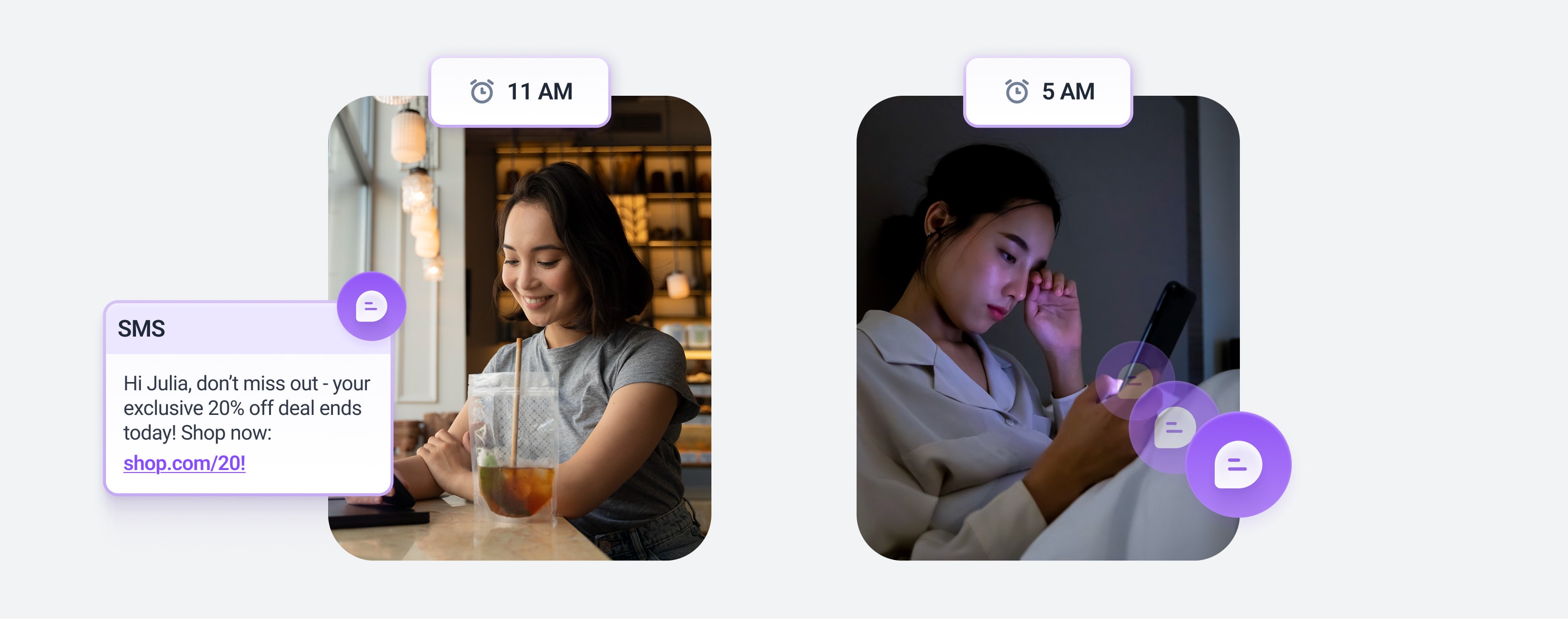
How Does Time Impact Open and Click-Through Rates?
Generally, midweek texts and well-timed dayparting lead to better engagement. Open rates are already quite high for SMS, but they can still fluctuate with timing. Most brands see open-rate spikes after 9-10 AM once people settle into their day, then again in the early evening.
But texts blasted out very early (10 PM, 6 AM, etc.) tend to be ignored until later (if not forgotten entirely). Even though technically the message was “delivered,” it’s not truly seen until the recipient is active on their phone.
People are generally more inclined to tap your link during natural downtime (lunch, after work) and less so during busy or off hours. For example, if you send a sale alert at 12:30 PM on a Tuesday, someone on their lunch break might happily browse and click. But that same person at 7:30 AM might swipe it away while rushing to work.
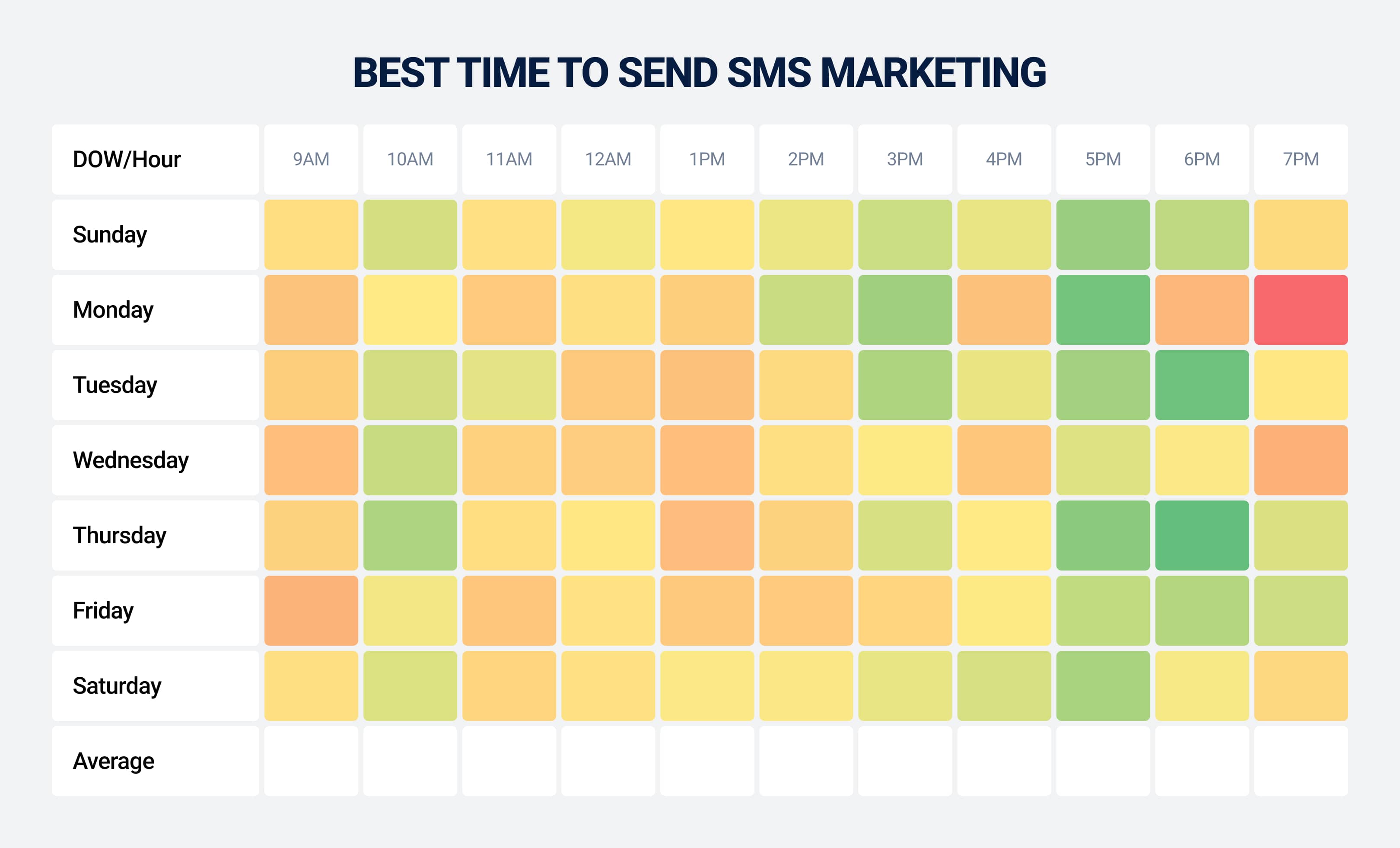
Best Days to Send SMS Campaigns
Every audience is different, but the data shows certain days consistently outperform others for marketing texts:
Tuesday Through Thursday Lead for Engagement
It turns out mid-week is prime time for texting. Multiple studies find that Tuesday, Wednesday, and Thursday messages see far higher click-through rates on average compared to Monday or Sunday.
People are in “weekday mode” here, but not yet mentally checked out for the weekend. From real campaign data, Tuesday and Thursday are consistently the best days. Attentive, an SMS platform that analyzed 25+ billion messages, found that texts on Tuesday and Thursday achieved the highest click-through rates of the week.
Thursday in particular often ranks as the single best day for marketing texts. People are over the midweek hump and starting to think about weekend plans (and purchases).
Weekend Sends Work for Time-Sensitive Campaigns
Weekends aren’t off-limits for SMS. They can work brilliantly for certain time-sensitive or leisure-oriented campaigns. People’s routines shift on weekends (sleeping in, running errands); so their phone habits do too.
Broadly, Saturday texts can perform well, especially for B2C messages in retail and food. For example, many food delivery services swear by Saturday late-morning texts (“Hungry? Get $5 off lunch if you order by 1 PM!”) because customers are relaxing at home or maybe recovering from a few drinks on Friday night and want to treat themselves.
Similarly, a wellness brand (think spa or fitness studio) might promote a weekend-only offer on Saturday and see strong uptake as users have more free time to indulge or book appointments. Same goes for affiliate marketing campaigns; customers engage better when they’re relaxed and not busy.
Industry data backs this up: retail and entertainment brands often see higher engagement on weekends than weekdays. A travel deal or event promo might shine on a Saturday when people are in planning or doing mode.
That said, weekends can be hit or miss depending on your audience. B2B or work-related texts generally flop on weekends (since those folks unplug), but B2C in verticals like wellness and travel can thrive by reaching people during downtime.
Worst-Performing Days (And When to Break the Rule)
By consensus, Monday is often the worst day to send marketing SMS campaigns. It’s no surprise because people are busy and a brand text is more of a nuisance than it is valuable on a Monday morning. The general rule: avoid Monday sends unless absolutely necessary.
Friday texts also see lagging engagement because people mentally check out by Friday afternoon, or delay non-urgent texts until later. However, Friday can shine for certain contexts: for instance, if your campaign ties into payday or end-of-week routines.
Many consumers get paid on Fridays, so they might be more receptive to spending offers then. Brands selling higher-ticket items or subscription renewals sometimes schedule reminders on Friday because they know you just got paid.
Ultimately, know your audience and break timing “rules” when your data tells you to. Perhaps your analytics show that, contrary to general trends, your customers love Monday evening texts (maybe your product is something that helps start the week off right).
Or maybe Sunday afternoons, which aren’t normally great for marketing, are prime time for your niche (e.g. a meal-prep company reminding subscribers on Sunday for Monday orders).
Data-Driven Best Time of Day to Send SMS
Knowing the right day is good. Next comes pinpointing the exact time of day to hit “send.” This is where things get really interesting, because consumer behavior fluctuates from morning to night.
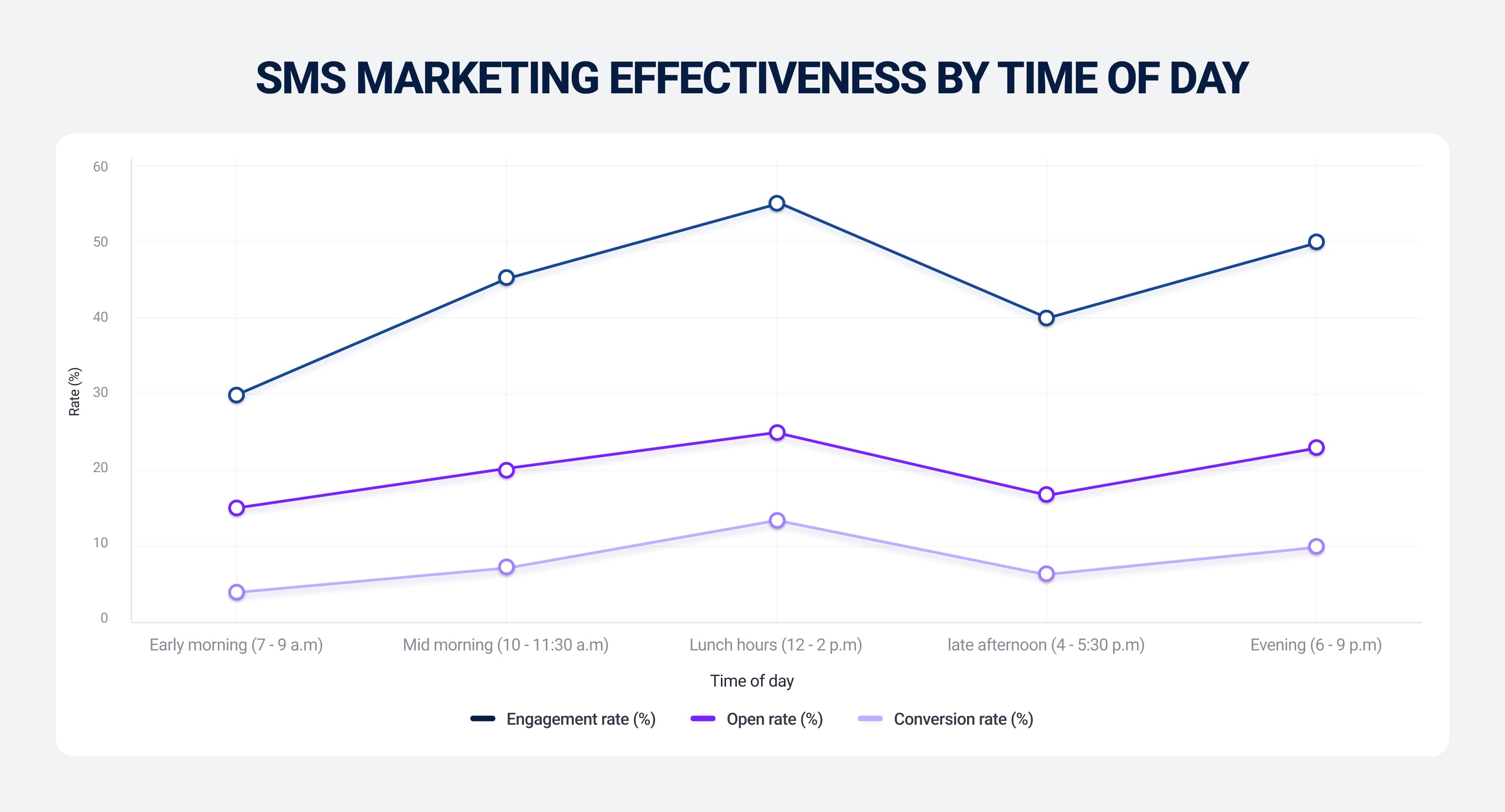
Morning Sends (9:00 AM – 11:00 AM)
Morning’s good, but there are a few caveats. A text arriving during 9-11 AM (recipient’s local time) often catches people as they check phones after starting their day. This timeframe is excellent for messages that are useful for the day ahead, like appointment reminders or daily to-do prompts.
For instance, a fitness app might send a 9:30 AM SMS saying, “Don’t forget your 5 PM yoga class today - reply Y to confirm your spot!”
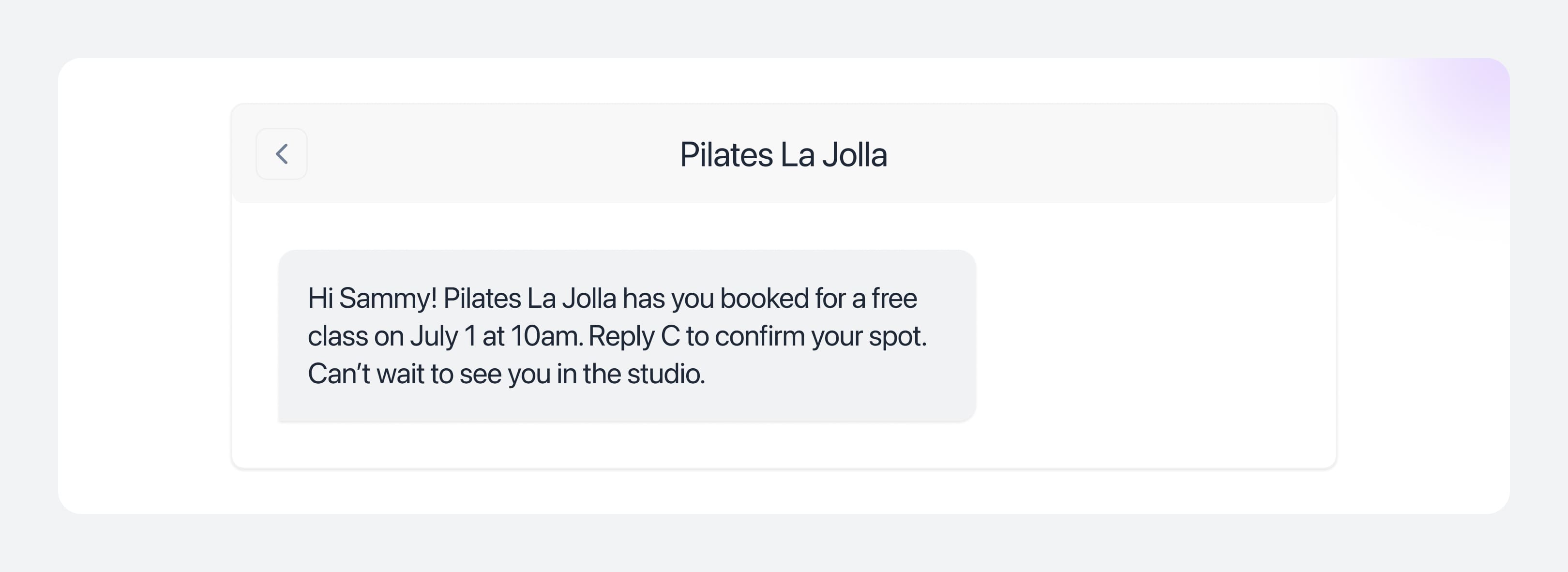
But timing is everything here: too early kills engagement. If you jump the gun and text at the crack of dawn (say 6-7 AM), you risk either waking the customer (yikes!) or having your message buried by the time they do wake up. Most regions also have legal/ carrier “quiet hours” forbidding marketing texts before 8 AM for this reason.
So aim for 9 AM local time, the time most people have gotten up, had coffee, and are scanning their notifications mid-morning.
Midday Window (12:00 PM – 2:00 PM)
The period between 12 noon and 2 PM tends to give the best results for SMS campaigns across all industries. Retail open rates and click-throughs are often highest around lunch. Consumers are relaxed enough to actually engage with promos.
For example, eCommerce brands frequently schedule flash sale texts right at 12:15 PM because they know shoppers are free to browse.
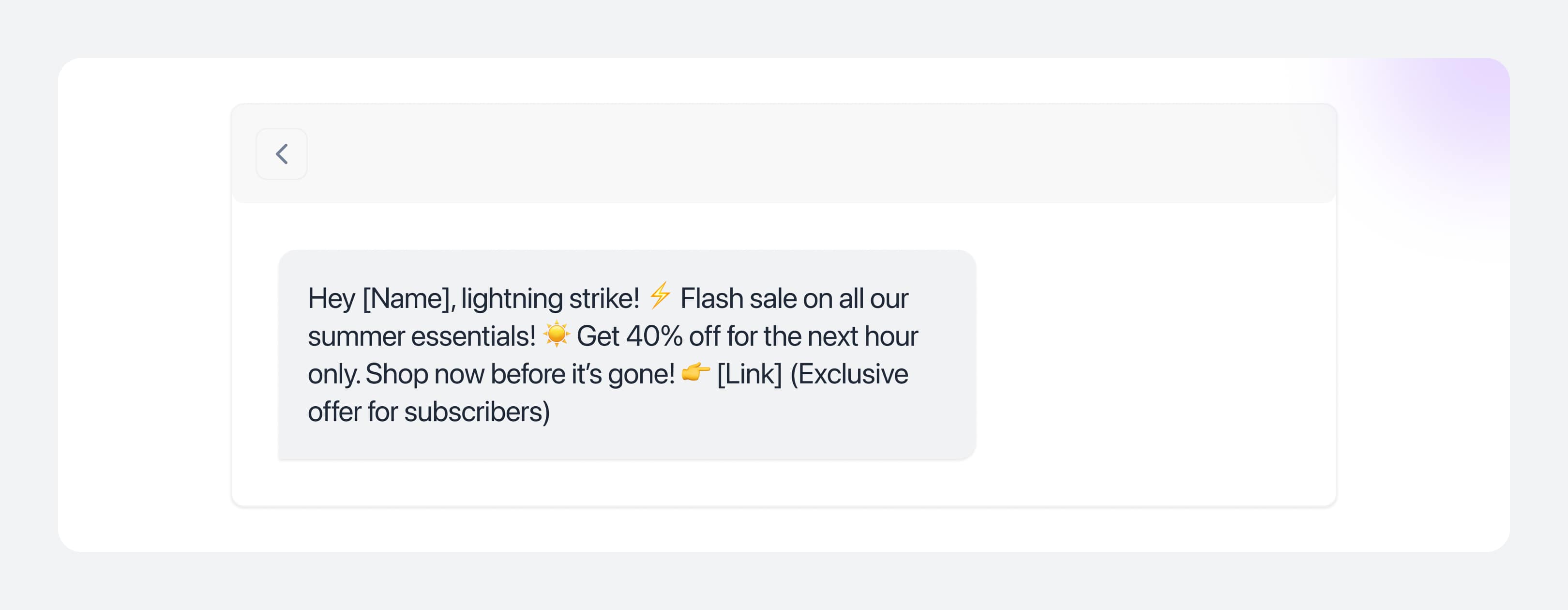
Late Afternoon and Early Evening (4:00 PM – 6:30 PM)
Late afternoon into early evening (roughly 4 to 6:30 PM) is often a peak window for eCommerce and B2C actions. People are wrapping up work or just getting home, so they’re on their phones decompressing.
This timeframe consistently shows high engagement for consumer-facing texts. In fact, we identified ~5-6 PM as the single best hour block for improving SMS click-through rates and minimizing opt-outs.
And this period also correlates with rising “buying intent.” People stop thinking about work and go to ‘personal life mode,’ which includes shopping or going out.
So if you have a brick-and-mortar component, a 4-5 PM text can literally catch someone as they consider stopping by on their way home. SMS is the perfect channel to tap into that moment because they’re already on their phones.
It’s also worth comparing SMS vs. email marketing for this time of day:
| Channel | Average Open Rate | Average Click‑Through Rate (CTR) |
|---|---|---|
| SMS | ~98% | 19-35% (varies by industry segment) |
| ~30-40% (varies by sector) | ~2-3% (range: 1-5% depending on industry) |
After 8 PM Sends: High Risk, Low Return
What about texting at night, say after 8 or 9 PM? In general, avoid it as much as possible for marketing messages. Late-night SMS sends are high risk and typically low return. By 8 PM onward, many people are shifting to quiet time (putting kids to bed, watching TV, etc.). A marketing text chirping in at 10 PM is more likely to annoy than entice.
In fact, U.S. regulations (and carrier guidelines) effectively ban promotional texts during the overnight “quiet hours” (usually defined as 9 PM to 8 AM).
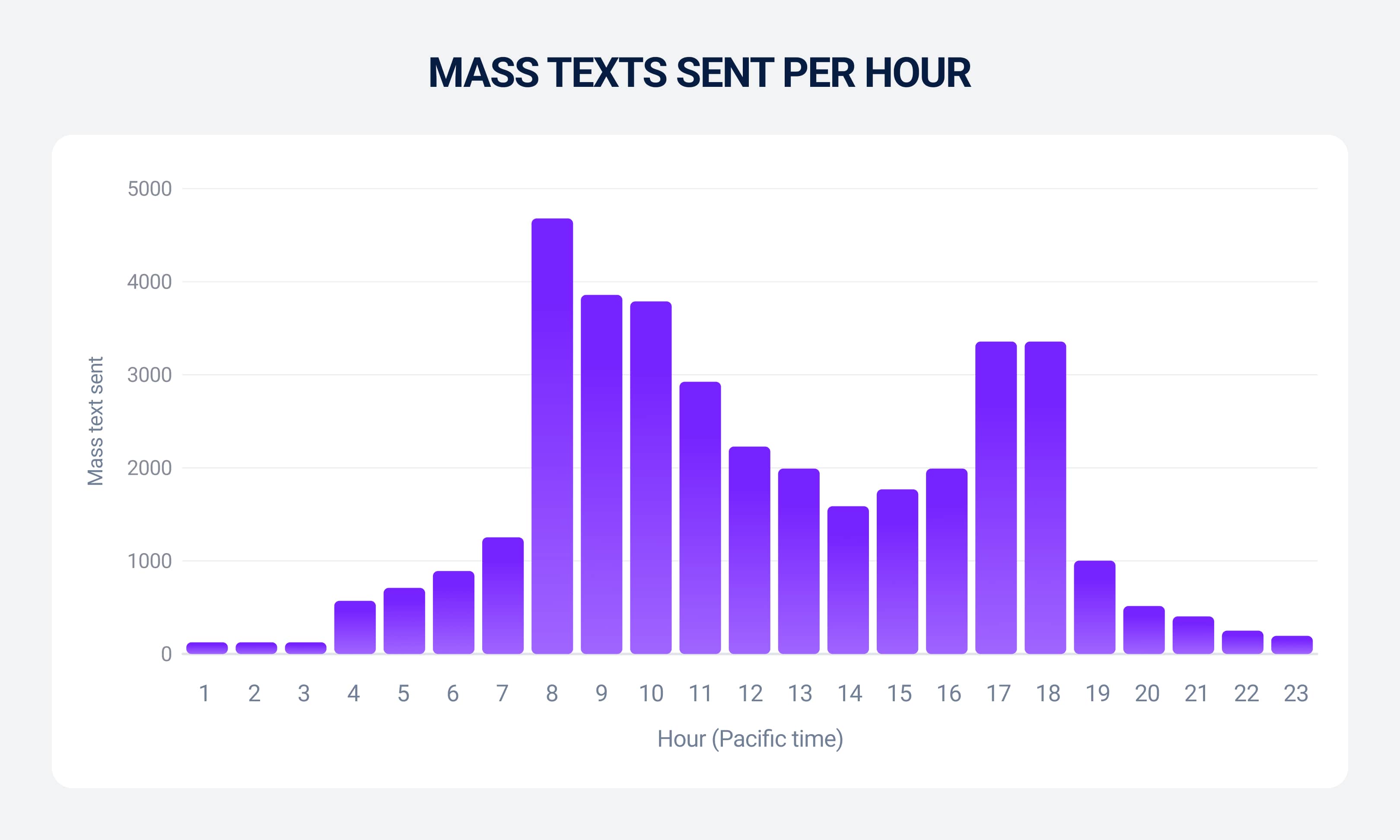
Most brands avoid nighttime sends unless it’s an urgent alert-style message. Are there any exceptions? A few niche cases: for example, a nightlife or events promoter might send texts at 9-10 PM to remind people or announce last-minute ticket drop, because that audience is awake and active then.
Or a streaming service might ping at 8:30 PM like, “New episode just dropped for your late-night viewing!” But these are edge cases where the content fits a late hour. Even so, those messages should ideally target only the segment that’s likely to appreciate it (night owls, specific time zones, etc.). Mass blasts after 8 PM broadly are a no-go.
SMS Marketing Timing Strategies for B2B and B2C Campaigns
SMS isn’t just a B2C game. Plenty of B2B companies use text messaging too (for events, demos, reminders, etc.). But the timing strategies can differ:
B2B SMS Timing
Generally, stick to classic business hours on weekdays. If you’re texting a professional about a webinar or meeting reminder, you want to reach them when they’re in work mode. That typically means 9 AM to 5 PM, Tuesday through Thursday for best results.
Avoid evenings and weekends, as many B2B contacts aren’t going to appreciate a work-related text in their personal downtime. For example, a software company texting a client about a scheduled demo is better off sending it maybe on Wednesday at 10 AM (when the client is at their desk and can confirm), rather than 7 PM on Wednesday when they’re eating dinner.
B2B audiences have professional schedules, so you want to align your texts accordingly. Mondays and Fridays for B2B can be problematic (Monday too hectic, Friday minds are already on weekend). So midweek midday tends to be best.
B2C SMS Timing
Much more flexible. With consumers, you consider their lifestyle, which might mean outside standard “9-5” windows. Evenings and weekends can be good for B2C, depending on the product.
For instance, a retail apparel promo might do great on a Saturday at noon or a Thursday at 6 PM. In B2C, you map to consumer free time and shopping behavior. If your target demographic is working adults, hitting them before or after work (e.g. 7 PM) can be smart since that’s when they shop online.
If your audience is students, maybe afternoons are fine since they look at phones all day. Essentially, B2C timing “rules” revolve more around evenings and weekends, which are times when people are not slammed with work or asleep. This is quite different to B2B, which is why we don’t give a blanket statement of the best time to send SMS marketing.
But consider segmenting your send times accordingly if you work with both B2B and B2C (for example, a services or content creation company with different client types). You might send essentially the same message at 11 AM Tuesday to your business clients and 6 PM to your consumer subscribers. You’re timing each for when it’s likeliest to be read.
GROW YOUR INSTAGRAM FOLLOWING VIA OUR CELEBRITY CAMPAIGNS
Leverage the power of the worlds A-list celebrities to grow your Instagram every month
VIEW CAMPAIGNSCampaign-Type Timing Based on Performance Data
Different types of SMS campaigns have different “ideal” timing:
| Campaign Type | Optimal Timing | Why It Works |
|---|---|---|
| Promotional and Sales Campaigns | Midday (12-2 PM) and early evening (5-7 PM). Ideally Tuesday-Thursday because people are most busy on Mondays. | People engage more when they’re on breaks or even after work when they’re receptive to promotions (‘Fancy a discount on this takeout?”) |
| Abandoned Cart SMS | Within 1 hour after cart abandonment, ideally within 10-30 minutes. | Quick reminders capitalize on buyer intent. This helps boost your conversion chances. |
| Appointment and Reminder Messages | 24-48 hours before appointment, plus a morning-of reminder (7-9 AM). | Early reminders improve attendance. |
| Holiday and Limited-Time Offers | Just before the holiday/event begins and a final reminder closer to expiration. | Urgency prompts immediate action; earlier texts capture interest, later reminders drive urgency. |
Segmenting by Audience Behavior and Local Tim
The average “best time” is useful, but your secret weapon is segmentation, which means tailoring send times to specific audience:
- Behaviors
- Locations
- Demographics
Send-Time Personalization Using Engagement History
Try to analyze each segment’s past engagement so you can personalize send times to those responses. For example, you might discover that one group of customers consistently opens/clicks texts in the evenings, while another always engages in the morning.
So you could schedule the first group’s messages for 7 PM and the second group’s for 10 AM instead of blasting everyone at noon. This works because it actually matches their preference. This is essentially send-time optimization at the segment or individual level. It’s similar to optimizing your website’s performance through good UX and SEO.
Say you have younger subscribers (Gen Z) and older subscribers (Boomers). Your data might show the younger crowd often clicks late at night (maybe they’re up browsing at 11 PM), whereas older people never do but often click early in the morning.
You could segment your list by age group and stagger the send (e.g. send to Boomers at 8 AM and Gen Z at 8 PM). This way each gets the message when they’re most likely to engage.
Time Zone Awareness for Global Lists
If you have customers or subscribers across different time zones (even within one country or internationally), time zone targeting is non-negotiable.
Nothing will tank your engagement faster than blasting a single send at say 3 PM Eastern and unknowingly hitting part of your list at noon and another part at midnight. The West Coast audience might get it at noon (no problem), but your international customer in London just got a 8 PM text at 1 AM their time.
Most modern SMS marketing platforms have a “send in recipient’s local time” feature. This automatically adjusts the timing based on the user’s area code or provided location info. For example, Klaviyo’s platform does this.
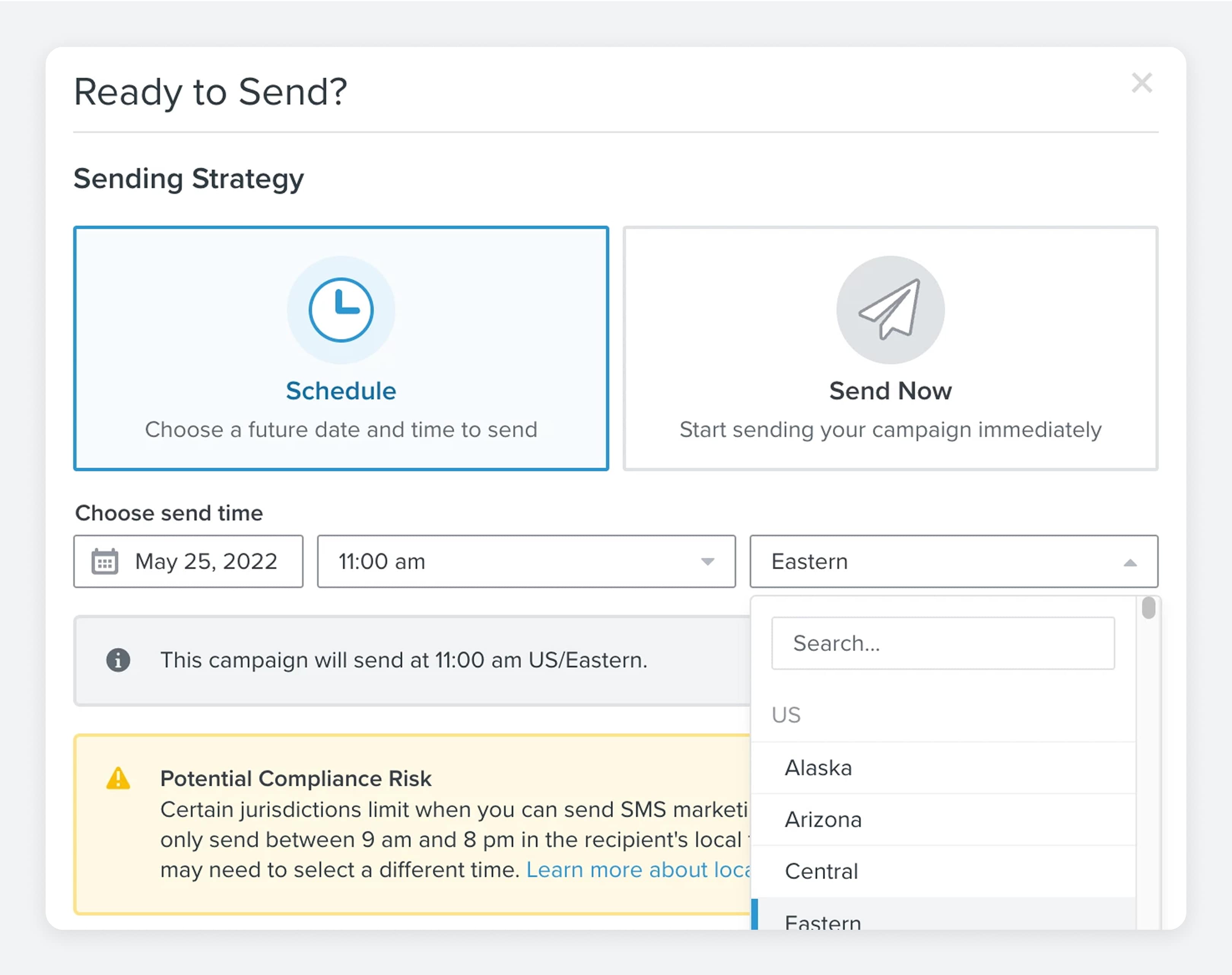
And note that little yellow box in the above example, too: acceptable messaging times can vary. For instance, in France it’s actually illegal to send marketing SMS on Sundays or after 8 PM.
Fortunately, Klaviyo’s platform adjusts to this automatically, but as a general rule, keep it within 9 AM - 9 PM local time for any marketing SMS globally.
Demographic and Industry Timing Variance
We touched on B2B vs B2C and age groups; let’s expand a bit:
Age and Lifestyle
Teenagers and college students often stay up later and use their phones at all hours, so they might respond to a midnight text. Don’t expect that with older consumers, especially retirees. They’re more active earlier in the day and rarely engage late.
Also consider working status, like a college kid’s schedule vs. a 9-to-5 office worker vs. a stay-at-home parent differ greatly.
If you market to, say, stay-at-home moms, maybe mid-morning weekdays (after the school drop-off rush) is prime, whereas that time might be bad for an office worker who’s in a meeting then.
Industry Timing
There are often known patterns based on what you sell or the service you provide. We covered a lot:
- Retail/eCommerce (good around lunch and evenings)
- Health and Wellness (best on weekdays in the morning because people consider health routines at the start of the day, plus laws often restrict health promo hours)
- Restaurants/Food: Late morning and late afternoon when people decide meals
- Entertainment (like concerts, events): More frequent promotion towards the weekends
- Finance or Utilities (likely strictly during business hours, since these are more formal and people handle them 9-5)
- Education (like a training program advertisement, maybe later in the day after classes)
This means you need to analyze demographic data against engagement metrics. If you have info like job title or purchase history, look for correlations with when they click or convert!
You might find patterns like “professionals engage mostly weekday evenings” or “parents mid-day while kids are at school”. Then adjust timing by segment as needed.
Also, watch seasonal behavior changes. Certain demographics change routines seasonally (e.g., during summer break vs school year for students). And don’t be afraid to survey or ask customers, too. A simple poll via SMS or email like “When do you prefer to hear about new deals? Morning/Afternoon/Evening”, could give you some good insight.
Tools That Help You Optimize SMS Timing
Manually figuring out and testing all these timing nuances isn’t easy, but there are numerous tools and features out there to help automate and optimize SMS send timing:
Send-Time Optimization Features (STO)
Many advanced messaging platforms offer Send-Time Optimization (STO), which is essentially AI-driven timing. These features analyze each subscriber’s engagement patterns and then automatically send your message at the predicted best time for that individual (or segment).
It takes the heavy data processing off your plate. For example, Klaviyo has a Smart Send Time feature for email and SMS that can test and determine ideal send times based on engagement data.
These features often work by first running an experiment (sending at various times to different cohorts) and then identifying which time gives you the highest engagement. After that, the system might continue to refine or apply that knowledge per user.
In practice, STO might mean you schedule a campaign for today, then the system delivers:
- John’s text at 10 AM
- Sarah’s at 1 PM
- Mike’s at 7 PM
It knows those are when they’re likely to click. The benefit is that you get the personalization of timing without having to manage hundreds of segments yourself. And this can noticeably lift metrics: Vibes mentioned seeing clients improve click-through rates up to 50%!
Some tools with send-time optimization or predictive features include:
- Klaviyo
- Postscript
- Attentive
- Braze
- Salesforce Marketing Cloud
- Even some SMS-focused tools like Emarsys or Omnisend have started integrating AI timing
So check if STO is available if you’re using one of these and give it a try. Just keep in mind that sometimes AI might choose odd times if data is sparse, so make sure it’s not going to send outside permitted hours (usually they have safeguards, but just in case).
Time-Based A/B Testing Engines
Some platforms have specific support for time-based A/B tests. For instance, Klaviyo allows you to A/B test send times by splitting your list and sending at two different times, then it can even automatically pick the winner for the remainder of your list if you want.
Here’s how you could do it:
- Take a campaign and split your audience randomly into, say, three groups
- Send group A the SMS at 10 AM
- Group B at 3 PM
- Group C at 7 PM (making sure all in same time zone or segment by time zone first)
- Track which group had the highest click-through or conversion rate
That gives you a data-driven answer for the best time for that particular message. You might want to repeat this across different days or campaigns to confirm consistency. Over time, you’ll build a heatmap of sorts for best times.
Some platforms provide engagement heatmaps by day and hour, which can show you at a glance where the green (high CTR) spots are. These visualizations are super handy to identify patterns and outliers.
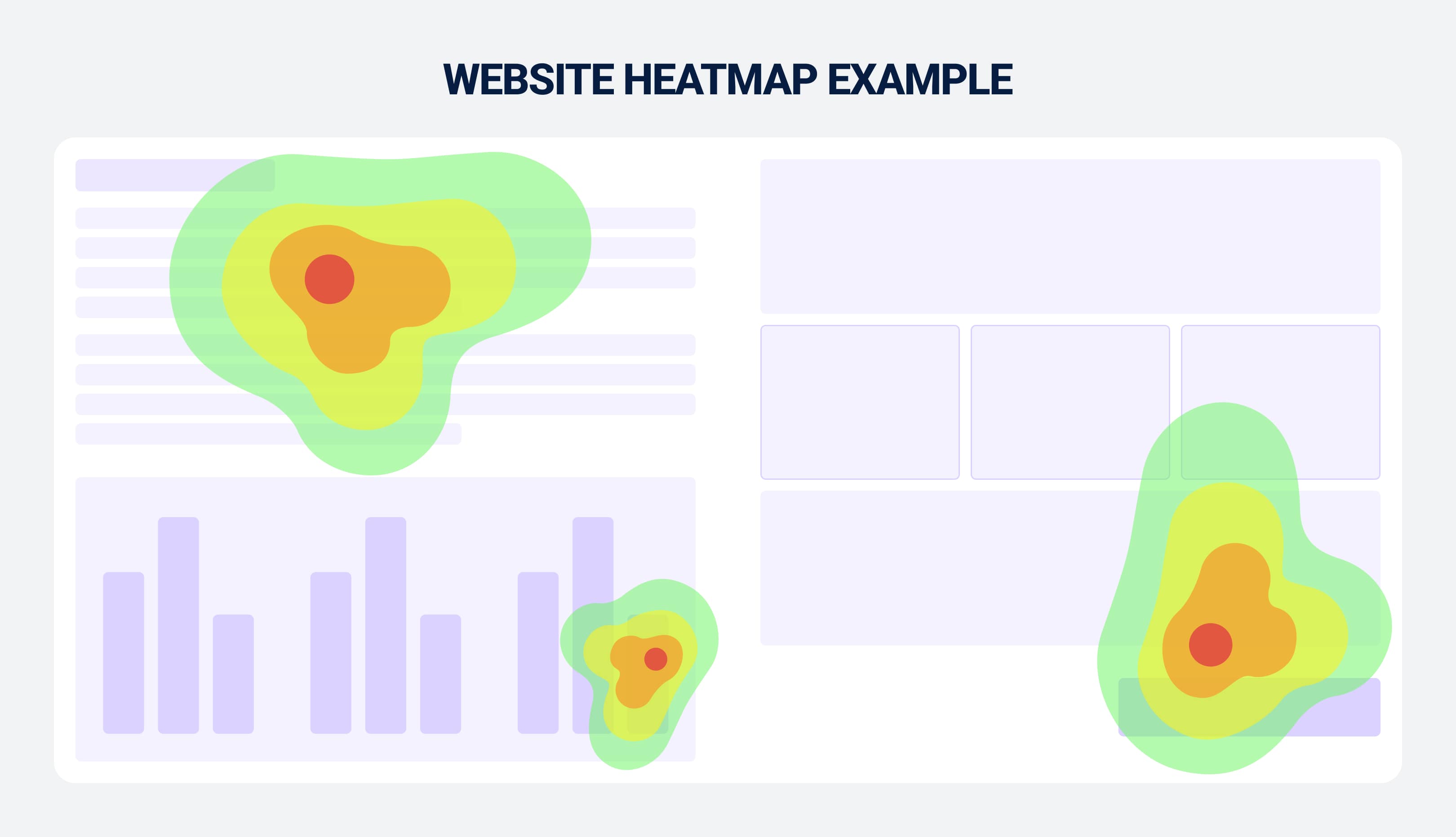
If your provider doesn’t have one, you can export data and use Excel or a BI tool to create one. It’s worth it: a time-of-day heatmap can reveal, for example, that texts sent in the 2-4 PM window underperform (maybe your audience is busy then), whereas 11 AM and 7 PM shine bright green with success. This is good insight to have.
Remember to also test frequency, time, and segment together sometimes. For example, A/B test not just 10 AM vs 5 PM, but also test sending on Tuesday 10 AM vs Wednesday 10 AM vs Thursday 10 AM in a multivariate way if possible.
Day and time also have an effect on each other. Some enterprise tools can set up multivariate tests covering day-of-week and time-of-day combos systematically. If not, you can run a series of A/B tests (e.g., first find the best day, then test times on that day).
Trigger-Based Campaign Automation
These are automated texts sent when a user does (or doesn’t do) something, rather than on a preset schedule. So the timing is inherently optimized: the message goes out at a naturally relevant moment.
For example, cart abandonment texts are a type of trigger:
- User leaves cart
- Wait X minutes
- Send SMS
Browse abandonment is another great trigger-based campaign:
- User views product but doesn’t buy
- Trigger a next-day SMS like “Still thinking about [Product]? It’s selling fast!”
Same goes for post-purchase follow-ups:
- User buys
- Two weeks later send a check-in or cross-sell SMS
So with all of these, the timing is as personalized as possible, based on either an action or a specific user milestone. The advantage is you don’t have to guess the right time because the customer’s action dictates it.
To do this, you’ll need tools like an automation platform that can set up these flows. Omnisend is good for strong automation flows (cart, browse, birthday) across email and SMS, and they report significantly higher CTRs on automated messages vs. campaign blasts.
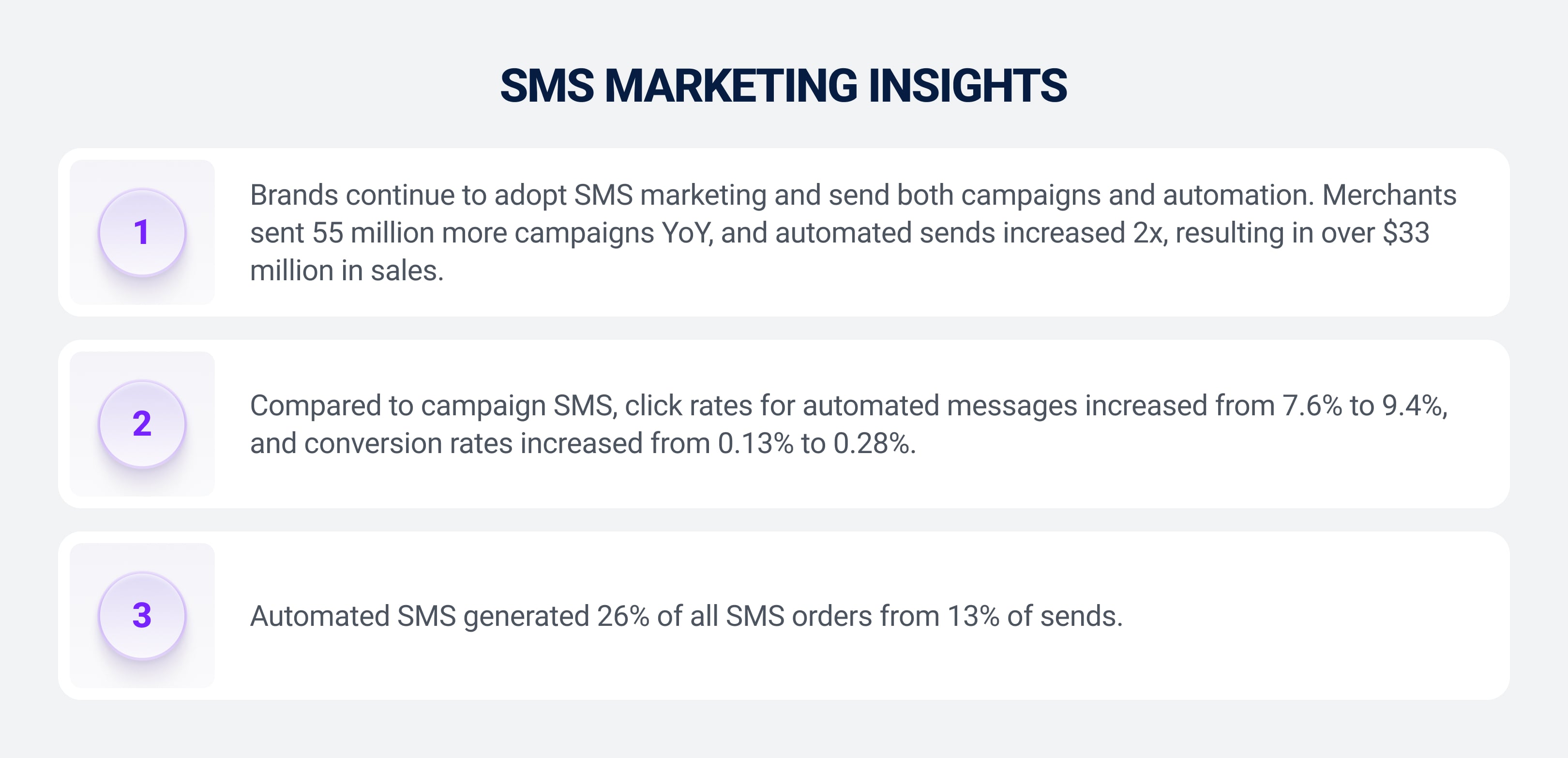
Real-Time Analytics Dashboards
Many SMS platforms provide dashboards that update essentially live (or with minimal delay) to show how your campaign is performing (everything from deliveries and clicks to conversions), often broken down by time.
For instance, say you send a campaign at 2 PM to 50k people. By 3 PM, your real-time stats might show that only a small fraction have clicked so far, whereas usually you’d see more by that point.
That could hint that 2 PM wasn’t a great time in this case. If you had planned a follow-up or a second wave, you might pivot to try a different time for the remainder of your list.
Or maybe you notice a ton of clicks immediately, which tells you this timing was spot on and you could consider using it again.
Some tools let you break down engagement by hour post-send. Infobip’s analytics mentions granular hourly engagement tracking. Others like Txt Cart or Just Call have reporting that highlights peak hours for engagement or when replies come in.
These can be effectively used as feedback loops: you clearly see exactly that most people opened your text within the first, say, 30 minutes, but conversions kept trickling in for 4 hours.
That might indicate your audience needs a few hours to act (maybe they wait until after work to check out even if they saw text at lunch). This tells you maybe send a bit earlier in the day so that by evening they take action.
How Dashboards Can Help
Real-time dashboards also help with deliverability monitoring. If you send at a suboptimal time when carriers are busy (all brands blast at noon on Black Friday), you might see slower delivery rates or queued messages.
If you notice this pattern, next time you might schedule slightly off-peak. Conversely, if deliveries are lightning fast and engagement is good, it means you hit a sweet spot where your messages weren’t throttled.
Some platforms let you make custom dashboards or reports that focus on time metrics. You might set up a widget for “Clicks by Hour of Day” aggregated across campaigns, which over a month might reveal an obvious spike at, say, 1 PM and 7 PM. These are good visual aids that work well with your heatmaps.
The overall idea is to use your analytics not just after but during campaigns and in planning. If your dashboard shows that by hour 2, your CTR is at 80% of what it usually achieves in total, you know the campaign will probably cap out lower than usual. Or if it blasts past expectations quickly, maybe timing was excellent, and you should replicate it.
5 Common SMS Timing Mistakes
Let’s highlight five common mistakes in SMS timing that you should avoid at all costs (and how to avoid them):
| Mistake | Why It Matters | How to Avoid It |
|---|---|---|
| Forgetting Local Time for Your Recipients | Messages sent at inappropriate times annoy users and lead to opt-outs. | Always segment by local time zones or use automated local-time scheduling. |
| Sending During Carrie | Violates regulations; messages may be filtered or blocked. | Schedule SMS campaigns strictly within allowed sending hours (8 AM-9 PM local). |
| Relying Only on “Best Practice” Timing | Generic timing recommendations may not fit your audience, which means less engagement. | Regularly A/B test send times and adjust based on your own audience data. |
| Sending Back-to-Back Campaigns | Frequent messages overwhelm your subscribers. This means more opt-outs and complaints. | Space campaigns thoughtfully. You can even use frequency caps to limit messages per subscriber. |
| Testing Timing Without a Control Group | Without proper control groups, you can’t accurately measure timing impact. | Conduct timing tests with control groups so you have a better idea of performance differences. |
Final Takeaways
A few recaps to leave you with: Respect your audience’s daily rhythms, because no one wants a 5 AM text, and use data to guide your decisions. Try to meet your customers when they’re most receptive (often midweek or early evening), and you’ll see higher engagement.
Try to avoid the temptation to blast out texts whenever it’s convenient for you, and instead make small tweaks like segmenting by time zone or testing an hour earlier vs. later. Ultimately, the “best time” is the one that aligns with your audience’s unique habits, so keep observing and optimizing. Tools like send-time optimization features can help you here.
Frequently Asked Questions
What’s the Ideal Time to Send Promotional SMS Offers?
Aim for midday (12-2 PM) or early evening (5-7 PM), especially Tuesday through Thursday. The former’s lunch time, the latter's after-work hours, so it would follow that people are more responsive during this time. And the data backs that up. Just make sure you avoid early morning and late-night hours.
Should I A/B Test SMS Send Times for Better Results?
Yes! A/B testing SMS send times lets you know when your specific audience is most responsive. It’s way easier to know the best times for engagement by comparing different send times with identical content. And it improves your click-through rates and conversions.
What’s the Worst Time to Send Marketing SMS?
The worst times are very early (before 8 AM) and late at night (after 9 PM). Try and avoid generally busy periods like early Monday mornings, too. Ask yourself if you’d like to be marketed at during those moments. So stick to daytime, when your customers are engaged and more open to receiving marketing messages without getting annoyed
Do SMS Messages Perform Better on Holidays or Weekdays
Generally, weekdays (especially midweek) tend to be the most reliable for SMS performance. However, retail holidays (like Black Friday) also see high engagement. Non-commercial holidays (e.g., Christmas Day) give you very low responses. So try to target shopping-driven holidays. The lead up to Christmas Day (just not on the day!), for example.
How Does Urgency in Messaging Affect the Send Time?
Urgency allows flexibility with send timing, as recipients act quickly if a message feels time-sensitive. For example, flash sales ending soon can succeed later in the evening than regular promotions. Still, avoid extreme off-hours; genuine urgency increases response rates when customers perceive immediate value or limited-time opportunities
Should I Personalize SMS Timing for Different Customer Segments?
Definitely. Personalizing SMS timing by segment (e.g., demographics, engagement history, local time zones) does wonders for engagement. Tailored timing aligns your messages with whatever preferences your individual customers have, which improves open rates and conversions. And using segmentation also ensures each customer receives messages at the optimal moment for them (when they’re most likely to convert).

